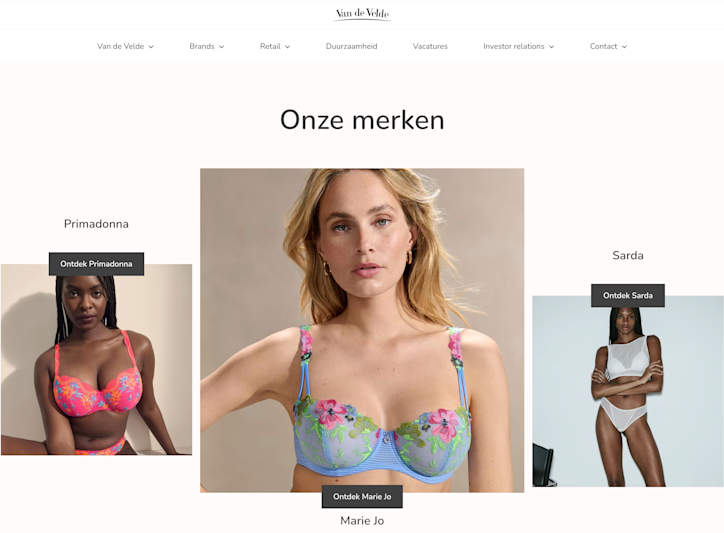Case Van de Velde
Websites: rigbyandpeller.com, primadonna.com, mariejo.com
Focus: Core Web Vitals, UX performance, business case development, SSR strategy

Van de Velde’s Roadmap to Business-Aligned Web Speed
About Van de Velde
Van de Velde is a Belgian company with over a century of experience in designing and manufacturing premium lingerie. They operate several well-known brands including PrimaDonna, Marie Jo, and Rigby & Peller. With a strong retail and wholesale presence across Europe and beyond, Van de Velde is known for its commitment to quality, fit, and style.
The Situation
Van de Velde manages five premium e-commerce brands across multiple European markets. While their websites were rich in content and brand identity, performance issues were negatively impacting the user experience, search visibility and conversion potential.
An audit showed that all five websites were failing Google’s Core Web Vitals across both mobile and desktop. Users faced long loading times, delayed interactions, and shifting layouts. Additionally, the current architecture based on Client-Side Rendering (CSR) was limiting both SEO performance and perceived speed.
Our Approach
We delivered a structured program to turn performance into a measurable business priority.
Performance Audit
Using a combination of synthetic and real-user monitoring tools, we conducted an in-depth analysis across all three websites:
SpeedCurve (Synthetic) for trend monitoring and debugging
WebPageTest for deep technical analysis and filmstrip visualisation
CrUX (Chrome User Experience Report) for public real-user data
SpeedCurve (RUM) for large-scale, ongoing field data
These tools allowed us to evaluate performance from both lab and real-world perspectives, across device types and user conditions. We identified the root causes of poor loading times, input delays, and layout shifts, particularly on mobile and product-focused pages.
Performance Audit
We analysed real-user data using SpeedCurve RUM and lab diagnostics to identify root causes of slow loading, input delays and layout instability across key pages.
Performance Business Case
We quantified how slow performance was affecting business results. Real-user data from mariejo.com and rigbyandpeller.com showed a clear correlation between conversion rate and performance metrics:
Conversion rates dropped consistently as LCP exceeded 2.5 seconds
INP above 150 milliseconds also led to a measurable decrease in conversions
By aggregating this data, we calculated the potential loss in conversion volume caused by suboptimal LCP and INP scores. These insights created urgency and gave stakeholders a clear understanding of the commercial impact of performance.
Performance Roadmap and User Stories
We documented performance issues as prioritised, actionable user stories and created a roadmap that focused on both immediate gains and long-term structural improvements. Focus areas included:
Optimising image formats and delivery
Reducing layout shifts on product and homepage templates
Addressing JavaScript execution and interaction delays
Fixing rendering order and decoding practices
Architectural recommendation
Based on our findings, we recommended moving away from Client-Side Rendering (CSR) toward Server-Side Rendering (SSR). CSR was delaying the rendering of key content, creating interaction delays, and making it harder for search engines to index and rank the site effectively.
Switching to SSR would allow Van de Velde to:
Improve loading speed and responsiveness
Render product content earlier in the load sequence
Create more stable pages with fewer layout shifts
Creates a balanced user flow where pages provide an equivalent user experience to minimise potential friction.
Ensure better crawlability and indexation for SEO
This recommendation was grounded in performance metrics as well as SEO impact analysis and examples of other companies that improved traffic and conversions after migrating to SSR.
Results so far
In the first phase, nearly half of the identified performance issues were resolved, primarily focusing on low-effort, high-impact items. Early outcomes included improved load speed, better performance on lower-end devices, and faster rendering of key product images.
The next phase focuses on more complex changes and deeper architectural improvements to unlock the full potential of performance gains identified in the business case.
Conclusion
For Van de Velde, improving performance was not just a technical objective. It was a strategic decision tied directly to business outcomes. The performance business case played a key role in quantifying the commercial impact, aligning internal stakeholders, and shaping a clear direction for improvement.
While early Core Web Vitals improvements were limited, nearly half of the identified performance issues have already been addressed. These initial fixes focused on foundational improvements including image optimisation, layout stability, and JavaScript execution. This work has laid the groundwork for deeper gains in the next phase.
Van de Velde now operates with continuous real-user monitoring via SpeedCurve RUM and has an active performance backlog embedded in its development process. Performance is no longer managed reactively. It is part of the way teams plan, measure, and deliver improvements.
Internally, performance is now better understood as a driver of user experience, SEO visibility, and commercial effectiveness. The focus has shifted from technical metrics to measurable impact.
Next steps include completing higher-impact roadmap items and exploring a transition to Server-Side Rendering. This architectural change is expected to significantly improve key metrics and help close the gap with top competitors in both speed and search performance.